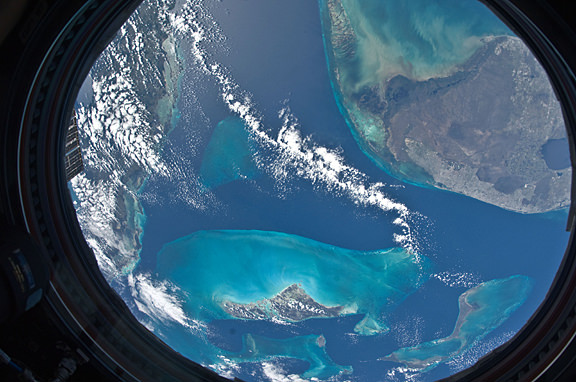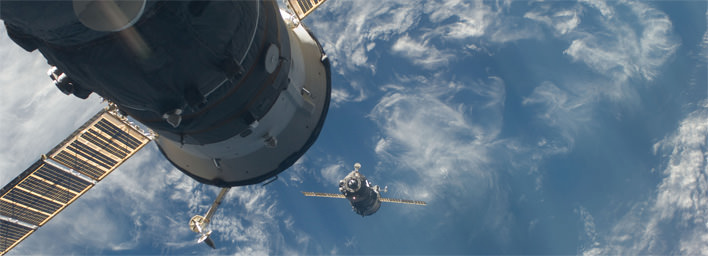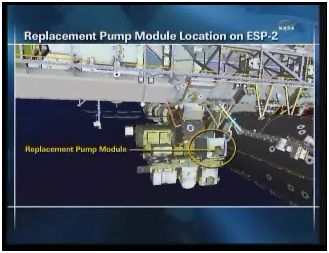Fret not Space Shuttle fans… If Orbital Sciences gets their way, a new mini space shuttle may be coming your way! I’m Benjamin Higginbotham and this is your SpacePod for December 15th, 2010
Continue reading “Orbital looking to build a mini Space Shuttle?”
Window to the World
[/caption]
A fish-eye camera view from the Cupola of the International Space Station shows a gorgeous view of Earth from space. Visible are parts of the Atlantic, Gulf of Mexico and Caribbean Sea, as well as the southern portion of the Florida peninsula, including the elongated metropolitan Miami area, Lake Okeechobee and the Florida Keys. This was taken by one of the Expedition 25 crew members on the ISS, from about 350 km (220 miles) above Earth. A 16mm f/2.8D lens gives this image a circular, fish-eye effect. Click on the image for access to higher-resolution versions,
Ten Years Of the ISS in Pictures
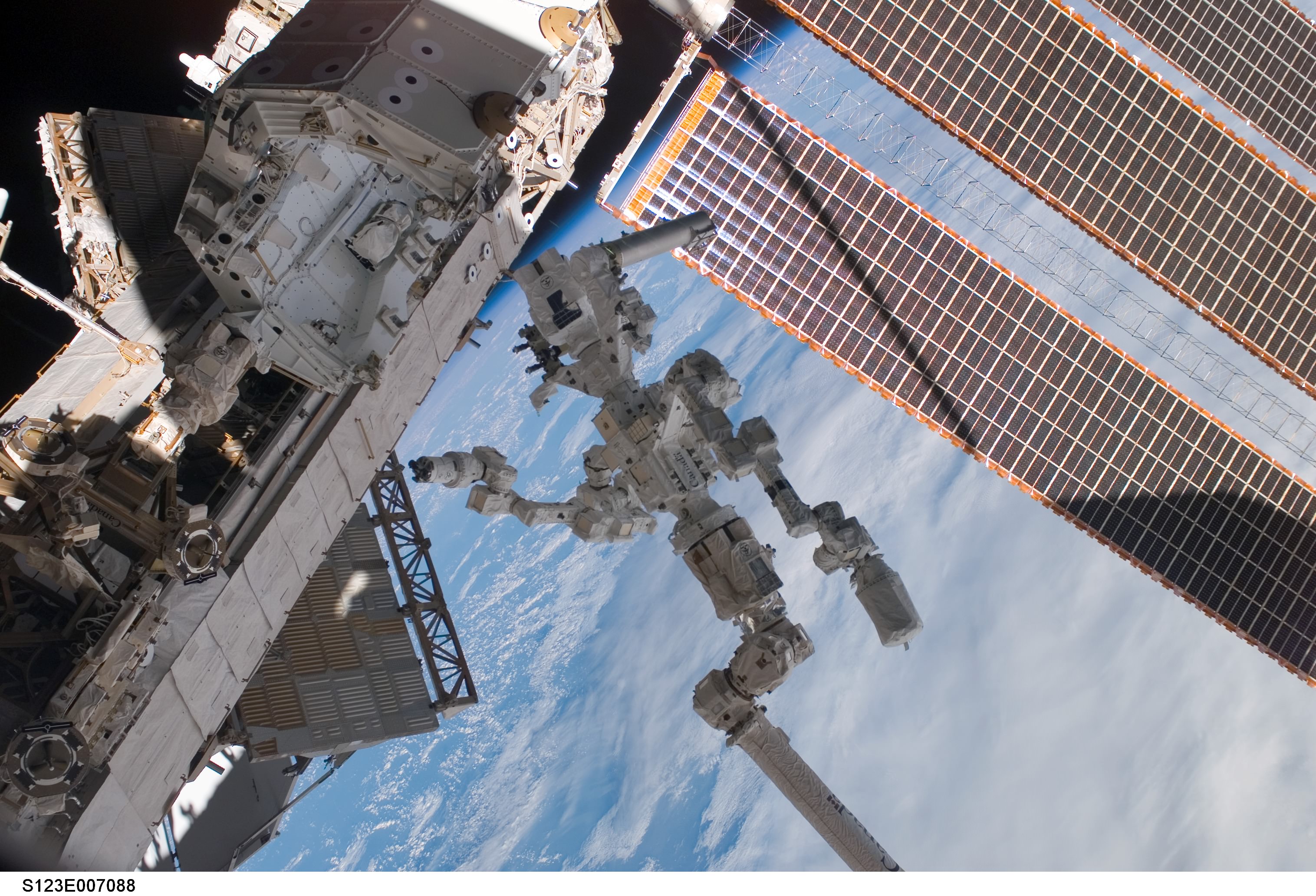
[/caption]
Ten years ago, the first Expedition crew arrived at the International Space Station. Here’s a look back in time at how the station has changed and grown, and some of the people who were there to make it happen.
And if you’re really feeling the love for the ISS today, check out our 2008 article, “I Heart the ISS; Ten Reasons to Love the International Space Station.”





















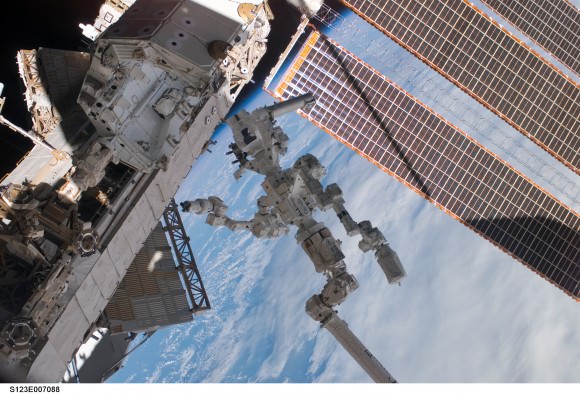







For a complete list of pictures of each of the ISS Expedition crews, see NASA’s gallery which shows all those who have served on the space station over the past 10 years.
10 Years of the ISS: First Commander Reflects on Anniversary
Ten years ago today US astronaut Bill Shepherd and Russian cosmonauts Sergei Krikalev and Yuri Gidzenko arrived at the fledgling International Space Station, after launching in a Soyuz rocket from the Baikonur Cosmodrome in Kazakhstan on October 31, 2000. This began a decade of continuous human habituation on board the station. The station’s first commander reflects on his mission and the past 10 years.
ISS Particle Detector Ready to Unveil Wonders of the Universe
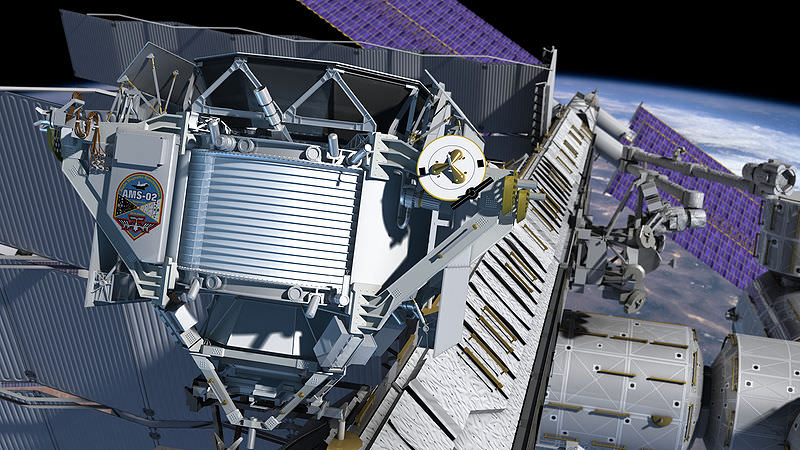
[/caption]
The Principal Investigator (P.I.) for the Alpha Magnetic Spectrometer-2 (AMS-02) experiment, Professor Samuel Ting, says that the experiment is already accruing data as it awaits its February 2011 launch date. Scheduled to fly aboard the final flight of the space shuttle Endeavour, STS-134, AMS-02 will search through cosmic rays for exotic particles, antimatter and dark matter. The experiment will be mounted to the outside of the International Space Station (ISS) and will require no spacewalks to attach.
Continue reading “ISS Particle Detector Ready to Unveil Wonders of the Universe”
Flying to the Moon — From the Space Station?
[/caption]
Last month the International Space Station partner agencies met to discuss the continuation of space station operations into the next decade and its use as a research laboratory. They also did a little forward thinking, and talked about some unique possibilities for the station’s future, including the potential for using the space station as a launching point to fly a manned mission around the Moon. I don’t know what our readers think, but my reactions is: this is just about the coolest idea I’ve heard in a long while! I’m having visions of a Star Trek-like space-dock, only on a smaller scale! In an article by the BBC’s Jonathan Amos, the partners said they want the ISS to become more than just a high-flying platform for doing experiments in microgravity, but also hope to see it become a testbed for the next-generation technologies and techniques needed to go beyond low-Earth orbit to explore destinations such as asteroids and Mars.
“We need the courage of starting a new era,” Europe’s director of human spaceflight, Simonetta Di Pippo, told the BBC News. For sending a mission to the Moon from the ISS, De Pippo said, “The idea is to ascend to the space station the various elements of the mission, and then try to assemble the spacecraft at the ISS, and go from the orbit of the space station to the Moon.”
One “next-generation” activity that is already planned is conducting a flight test of the Variable Specific Impulse Magnetoplasma Rocket (VASIMR) engine on the ISS, which is the new plasma–based space propulsion technology, that could get astronauts to destinations like Mars much quicker than conventional rockets. NASA has sign a commercial Space Act with the Ad Astra company (which is lead by former astronaut Franklin Chang Diaz).
But starting a Moon mission from the ISS is really a far-reaching, kind of “out-there” concept. It would be reminiscent of Apollo 8, and be the first of a new philosophy of using the station as a spaceport, or base-camp from where travelers start their journey. The propulsion system would be built at the station then launched from orbit, just like space travelers have dreamed for decades.
Of course, this is just an idea, and probably an expensive proposition, but isn’t it wonderful that the leaders of the space agencies are even thinking about it, much less talking about it?
Of course, doing zero-g experiments would always be the main focus of the ISS, but just think….
With this type of mission, the future of spaceflight actually be as Canadian astronaut Chris Hadfield describes in the video below. “This is the great stepping off point of to the rest of the universe,” says Hadfield, who will be commanding an upcoming expedition on the ISS. “This is an important moment in the history of human exploration and human capability,… and the space station is a visible sign of the future to come.”
Read more about the idea of an ISS-based Moon mission at BBC.
Undocking Problems Delays Soyuz, Station Crew Return to Earth
[/caption]
Two Russian cosmonauts and an American astronaut were forced to call off their scheduled departure from the International Space Station because of a failure of the undocking system. Hooks on the space station’s Poisk module docking interface failed to release for the scheduled departure at 9:35 p.m. EDT Thursday, sending astronaut Tracy Caldwell-Dyson and Russia’s Alexander Skvortsov and Mikhail Kornienko back inside the ISS from the Soyuz, where they were strapped in, ready to return to Earth. NASA and the Russian Space Agency are hoping to try again, with the hatch closing at 6:45 pm EDT on Friday; undocking at 10:02 pm and landing in Kazakhstan at 1:22 am.
“The preliminary analysis, according to the technical commission, showed that a false signal appeared in the onboard computer system about the lack of a hermetic junction after closing the hatch on the station,” said Roscosmos head Anatoly Perminov.
This type of undocking problem has never happened before and comes three months after a Russian Progress resupply vehicle had problems docking to the ISS when a transmitter for the manual rendezvous system accidently activated, overriding the usually reliable automated system.
In trouble shooting the problem, Expedition 25 flight engineer Fyodor Yurchikhin on board the station removed a cover from the docking mechanism and found a small gear floating away. But the station crew couldn’t confirm the object came from the docking system or had anything to do with the failure.
Time Lapse Video of Earth from Space
This time lapse footage was taken by astronaut Don Pettit — of Saturday Morning Science and the Zero-G coffee cup fame — during his time on the International Space Station. It shows Earth from day to night and back to day again. Pettit was on the ISS from November 23, 2002 to May 3, 2003, so he was in space when the Columbia accident happened. Pettit is one of the most interesting and quirkier astronauts and I hope he gets to return to the ISS. is scheduled to return to the ISS in 2011 (thanks to Ben H. for clarifying — see comments). This video provides some great views of Earth, especially at night, that can’t be captured with a regular video shot. Stunning.
via @wiredscience on Twitter
Spacewalkers Remove Failed Pump Module on ISS; Two More EVAs Needed to Complete Repairs
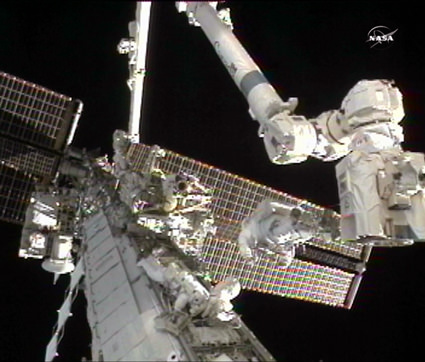
[/caption]
Overcoming a disappointing spacewalk last weekend, today astronauts Doug Wheelock and Tracy Caldwell Dyson successfully removed the failed ammonia coolant pump module on the S1 truss of the International Space Station. But NASA managers said that at least two more EVAs will be required to complete all the repairs to the critical cooling system. Earlier, it was hoped that two spacewalks total would allow enough time, but it will take at least four. “There were a number of challenges in the first EVA that set us back, but as we looked closer at this, we were hedging our bets at how many EVAs we had ahead of us,” said Spacewalk officer David Beaver at a press briefing following the successful EVA today. “As we have done more and more work in laying this out in a stepwise fashion, it became clear to us early on that this was a much bigger set of EVAs than we originally made time for.”
He added that on orbit, the astronauts have stopped all research in order to save on the cooling system. The complex systems keeps the station from overheating and the six-member crew has relied on just one — instead of the usual two pumps –to handle the cooling ever since the one pump failed during a power surge on July 31.
“The system has been kind to us and we haven’t had any more failures,” Beaver said.
The spare pump will be installed on the S1 truss during a spacewalk that is now scheduled for Monday – originally it was set for Sunday, but NASA managers decided an extra day would help both the astronauts and the teams on the ground preparing for the EVAs.
Wheelock and Caldwell Dyson were able to close the quick disconnect valve for the final fluid connector for the failed ammonia pump module, and then detach the final fluid line from the failed ammonia pump module – which was the problem that couldn’t be overcome on the first spacewalk.
The two astronauts then extracted the pump module and stowed on another location on the truss, and Caldwell Dyson prepared the spare pump for installation on the next spacewalk on Monday.
The spacewalk lasted 7 1/2 hours, slightly shorter than Saturday’s eight-hour marathon, the longest EVA at the ISS without a space shuttle present. Wheelock and Dyson had to use decontamination procedures after the spacewalk just in case some ammonia leaked on their suits.
In response to the power-saving reconfiguration that has had to be done, the science team worked quickly to establish a plan to preserve experiment samples in the Japanese Experiment Module freezer. The on-orbit crew was able to transfer all the samples from the freezer in the Kibo laboratory to an operating freezer. No sciences samples were lost due to the pump module anomaly.
While the crew schedule has been interrupted to support the newly added spacewalks, the payload ground teams have been working closely with mission controllers to preserve and re-plan high priority activities. Other activities that can be rescheduled with little or no impact are being postponed to a later date.
NASA Schedules Two “Emergency” EVA’s to Fix Cooling System
[/caption]
*Updated at 11 pm CDT — dates have changed for EVAs.
Two spacewalks will be required to remove and replace a pump on a critical cooling system on the International Space Station, and NASA is hoping to have station astronauts and ground teams ready by Thursday, August 5 Friday, August 6 for the first EVA. The pump module failed over the weekend, prompting a shift to a backup system, while other systems were shut down as a precaution. The backup system is working perfectly, and having a second system failure is highly unlikely, but NASA does not like to operate on a “single-string” system without redundancy. “Having another failure would be a serious situation for the program that we want to avoid,” said ISS program manager Mike Suffredini.
Update:
NASA had originally scheduled the first EVA for Thursday, August 5 and the second for Sunday, but decided late Monday that they needed more time for both astronauts and ground crews to prepare. Now, the first spacewalk will be Friday morning, starting at 6:55 a.m. EDT, (1155 GMT) with the second EVA on Monday, August 9.
An EVA was already scheduled for August 5 for astronauts Doug Wheelock and Tracy Caldwell Dyson to install part of a robotic crane and to prepare for a new module due to arrive in November aboard space shuttle Discovery. But that work will be postponed in order for the astronauts to do the priority fix.
“Typically, we allow two weeks to prepare for this type of EVA, but we decided to take advantage of having an EVA already scheduled, so this is a very aggressive approach,” said Flight Director Courtenay McMillan, who is leading the team supporting the spacewalk.
This type of EVA is part of what is called the “Big 14” set of contingency spacewalks that all ISS astronauts train for in the event of system failures like the one that happened on Saturday.
Suffredini said he is confident everyone can be ready. “The crew is in great spirits and are ready to do this,” he said. “These Big 14 EVA’s cover major systems repairs that an increment crew might have to do without the shuttle there. They train for both specific and generic spacewalks, and this particular one they have trained for. So they have some familiarity with the tasks they will be asked to do.”
Additionally all the operations teams have been working around the clock to prepare for the fix. “The ops team is full up for support,” Suffredini said. “If you were to go in the control room, it looks more like a shuttle flight is going on right now. We do train for these kinds of anomalies, and have been fortunate that we haven’t had to deal with anything like this before, but we have good plans in place.”
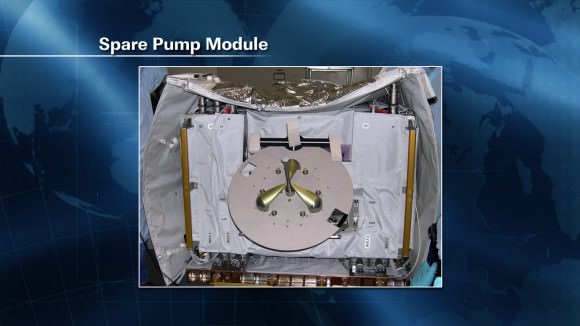
The pump — which was installed in October 2002 — failed Saturday night after a spike in electrical current tripped a circuit breaker. When the 350 kg (780-pound) pump failed, it shut down half of the station’s cooling system. Efforts to restart the pump, which feeds ammonia coolant into the cooling loops to maintain the proper temperature for the station’s electrical systems and avionics, were not successful. Suffredini said data suggests the motor is not frozen, as it did begin to pump when they did the restart, so that tells them there is likely a short in the electrical system.
The station’s crew worked with Mission Control to put the station in a stable configuration. The crew, which is in no danger, has resumed normal work activities and most of the systems are up and running. One freezer was shut down, but frozen specimens which are to be returned to Earth were transferred to another freezer.
McMillan said astronauts Cady Coleman and Sunny Williams are working today in the Neutral Buoyancy Lab — the big pool where astronauts train for EVAs — doing development runs for the emergency EVAs.
“They are doing the tasks that they forsee we’ll need to do, trying to work out details of the timeline,” she said. “And depending on how things go today we’ll see if we’ll be ready for the EVA.”
There are spare pump modules already on board the station, and Suffredini said that if more modules are needed, they can fit on board the Japanese HTV resupply vehicles or SpaceX’s cargo vehicle, and don’t need to be brought up by the space shuttle.

